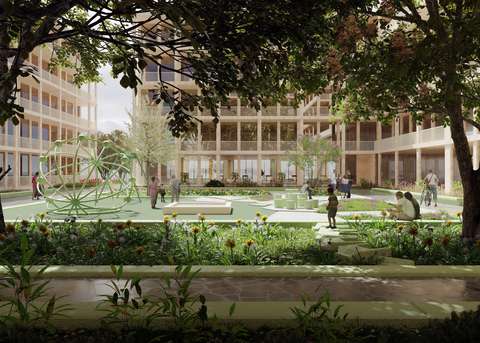Is there a new life for used concrete elements in landscape construction?

The Yellow office and landscape architect Niilo Tenkanen’s concept “Keran urbaani vihreä”, which succeeded in the Kera design competition, examines the reuse of concrete elements that are dismantled intact in landscape construction. The idea plan of the concept offers an opportunity for practical piloting of the circular economy of construction.
By reusing building materials and elements, it is possible to achieve significant benefits ranging from reducing emissions and waste to conserving natural resources and new business opportunities. There is a great need for solutions that accelerate the circular economy in the construction sector, as construction consumes approximately half of the world’s natural resources each year. The new Construction Act, which will enter into force in 2025, will also strongly promote the circular economy.
Reuse potential in landscape construction
The Yellow Office and Niilo Tenkanen’s concept “Keran urbaani vihreä”, which was successful in the Kera design competition, shows how parts of the Kera halls could be utilised in the landscape architecture of the area. According to the concept, the building elements of the old logistics centre are suitable for a wide range of uses in landscape construction, replacing new production of concrete parts, such as retaining and edge walls, planter box bridges and walkways. Steel bridges found at the Kera halls could be suitable for crossing larger planter boxes or stormwater basins, and dismantled floor pieces could be utilised, for example, on paved surfaces instead of concrete, granite or brick paving.
The concept includes an idea plan for both street areas and courtyards. In addition to the reuse of concrete elements, the core of the concept includes rain gardens, i.e. depressions covered with vegetation to support rainwater management, which increase the diversity of urban nature and improve storm water management. In addition to ecological sustainability aspects, the concept weighs the perception of what the built environment can look like: utilising materials covered with a patina found in the area in landscape construction creates an environment that is visually and atmospherically linked to the history of the area.
From idea to implementation
The suitability of the Keran urbaani vihreä concept, i.e. concrete elements transformed for outdoor use lying on the ground, for the new purpose could be demonstrated by testing a few elements. According to a statement(external link, opens in a new window) published by the Ministry of the Environment last summer, no CE marking is required for reusable building parts, meaning that it is possible to demonstrate the suitability of the parts per building site.
In all landscape construction, the stress on structures caused by weather, seasons and maintenance must be taken into account. Damage can be prevented by weather protection treatment of concrete elements, and any cracks can be patched and repainted as part of maintenance. “An industrial, rugged history is part of the nature of our concept. It would be great if Kera’s landscape looked layered and boldly in line with the circular economy. We hope that the concept will arouse interest and increase the demand for used parts and materials, so that we can move on to the piloting and practical implementation of reuse in the near future,” says Niilo Tenkanen, the team’s landscape architect.
The concept report is available for download below. See also the other concepts of the design competition:
Downloadable files
- Keran urbaani vihreä_konseptin raportti.pdfFile is only available in Finnish
More information
The design competition was carried out as part of the Implementation Pathway for Environments that Accelerate Sustainable Growth project of Espoo, VTT, Aalto University and Omnia, in which the city district of Kera is being developed as a development environment for the circular economy and the green transition together with citizens, companies, educational institutions and research organisations. The project has been implemented with the European Union’s REACT-EU ERDF funding, which is part of the European Union’s response to the COVID-19 pandemic.